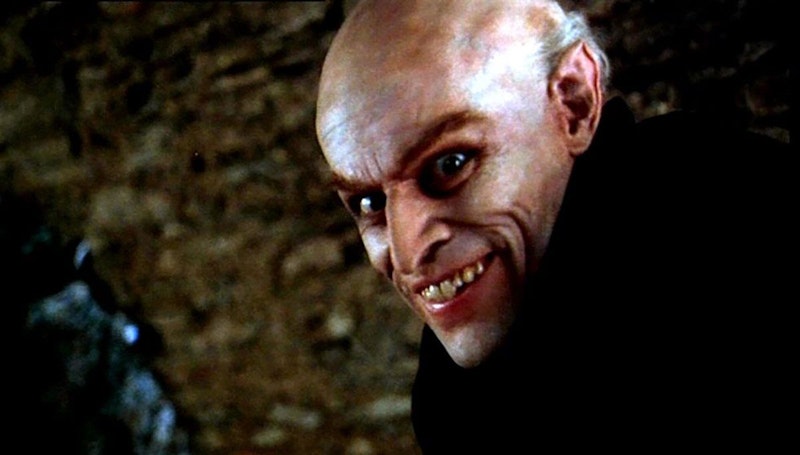Nobody loses it on film the way John Malkovich does. There’s something wholly different about anger and frustration “Malkovich style,” a post-modern, deconstructive performance that harkens back to the past. We catch glimpses of Shakespeare, Commedia dell’arte, and American slapstick—all in one big artistic package.
Such a cinematic manifestation is especially illuminated in E. Elias Mehrige’s Shadow of the Vampire (2000), a fictional account of F. W. Murnau’s filming of Nosferatu (1922), a film that’s considered a masterpiece not only of the silent era but also in a larger context of cinema itself. Murnau was intent on adapting Bram Stoker’s 1897 novel, Dracula, however Stoker’s heirs refused to give Murnau the copyright. Murnau went ahead anyway, changing the name of Count Dracula to Count Orlok and ways in which Orlok disposes of his victims, but the story essentially remained the same.
Although Shadow of the Vampire retains the horror elements of Murnau’s Nosferatu, Mehrige twists the tale in such a way that his film becomes a story of the relationship between a filmmaker and an actor. The actor in this case is Max Schreck who plays Count Orlok, who in turn is played by Willem Dafoe. The crew is confused and slightly angry with Murnau. Why are they leaving Berlin to make a film about which they have very little knowledge? What’s worse, none of the crew have any idea who this man, Max Schreck, really is, and why does he insist on remaining “in character” throughout the entire duration of the shoot?
Dafoe’s Max Schreck/Count Orlok is frightening. The make-up is superb but Dafoe’s heavy accent, walking gait, and look of pure terror often transcend even the great work of the make-up and costume department. His presence alone brings fear and uneasiness.
Murnau’s crew is uneasy alright. Albin Grau (played by the singular Udo Kier), Murnau’s producer and art director, is convinced that Murnau has crossed the line between art and reality. He doesn’t appreciate that Murnau keeps him in the dark but he is not alone in feeling this way. Because of Murnau’s obsession with Schreck/Orlok, the crew is feeling unfairly ignored and ostracized. Murnau’s a tyrant and couldn’t care less if his obsession is harming others. He has no empathy when the crew begins to get sick under strange circumstances. The show, or in this case, the film, must go on.
One by one, the film crew are in some fashion overtaken by the power Schreck/Orlok exerts. Much like a typical vampire, Schreck wants to be seen only at night, which makes the shoot even more difficult and cumbersome. Murnau continues to yield to Schreck’s demands in order to achieve the artistic result he yearns for. In addition, Murnau has “promised” to give Greta Schröder who plays Ellen Hutter (a version of Mina Harker in Stoker’s novel) to Schreck/Orlok.
Things continue to devolve. Most notably, Murnau is falling deeper into artistic madness, and has successfully dehumanized his entire crew. As if the plague of Schreck/Orlok has descended upon the town and the filming, the crew have lost their wills to go on, or to fight Murnau.
It’s clear that at the center of the film is the power struggle between Murnau and Schreck/Orlok. Since Mehrige has created fictional characters out of the real film director “F.W. Murnau” and real actor “Max Schreck,” he has inevitably developed a distance from reality itself. The actual past or biographical details about Murnau’s or Schreck’s life are unimportant. They are mere vehicles for Mehrige’s vision of art. How far does a film director go in order to achieve a masterpiece? Are ethics of making a film completely suspended during the shoot because actors’ (or crew’s) lives don’t matter? Are aesthetics the only thing that matters? Is “beauty” prized above all other forms and spheres of life?
In Mehrige’s fictional creation, Murnau says yes to all those questions. Malkovich embodies madness and gets lost in his own vanity while Schreck/Orlok disposes of his crew, one by one. All of this is captured on camera, and Murnau doesn’t hide his pleasure. One isn’t certain whether he comprehends that Schreck/Orlok is murdering his crew or if he’s oblivious to that reality. This is what renders Murnau even more tyrannical and certainly unlikable.
As the film reaches its end, as Murnau captures evil on film, he demands that Schreck/Orlok continue to “act” and do another take. “If it’s not in the frame, it doesn’t exist!” yells Murnau. Like an obedient rat, Schreck/Orlok obeys.
The crew that has escaped Orlok’s bite plead with Murnau to stop filming, but the madman can’t be stopped. Instead, he demands an end slate for the camera. His blind madness ends and uneasy calmness begins with his final words: “I think we have it.” For “Murnau,” no sacrifice is too small for the achievement of Art.

